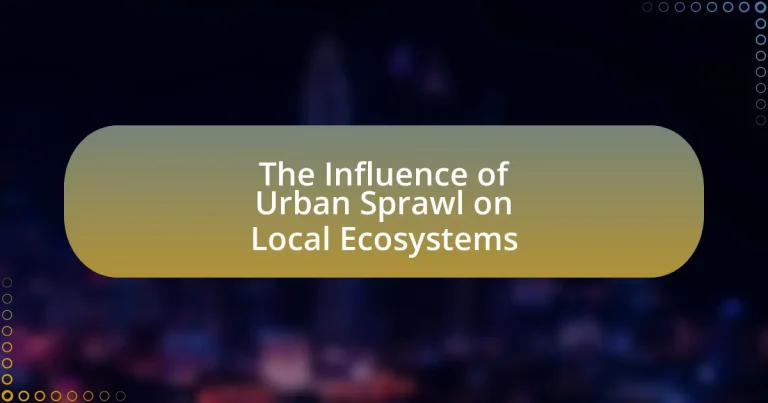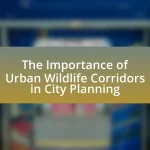Urban sprawl refers to the uncontrolled expansion of urban areas into surrounding rural land, significantly impacting local ecosystems. This phenomenon leads to habitat fragmentation, increased pollution, and a decline in biodiversity, as natural landscapes are converted into residential and commercial developments. Key species such as amphibians, birds, and mammals are particularly affected due to disrupted habitats and increased human activity. The article explores the ecological consequences of urban sprawl, including its contribution to climate change, pollution, and the factors driving this expansion, while also discussing strategies for mitigating its negative effects on local ecosystems through sustainable urban planning and community initiatives.
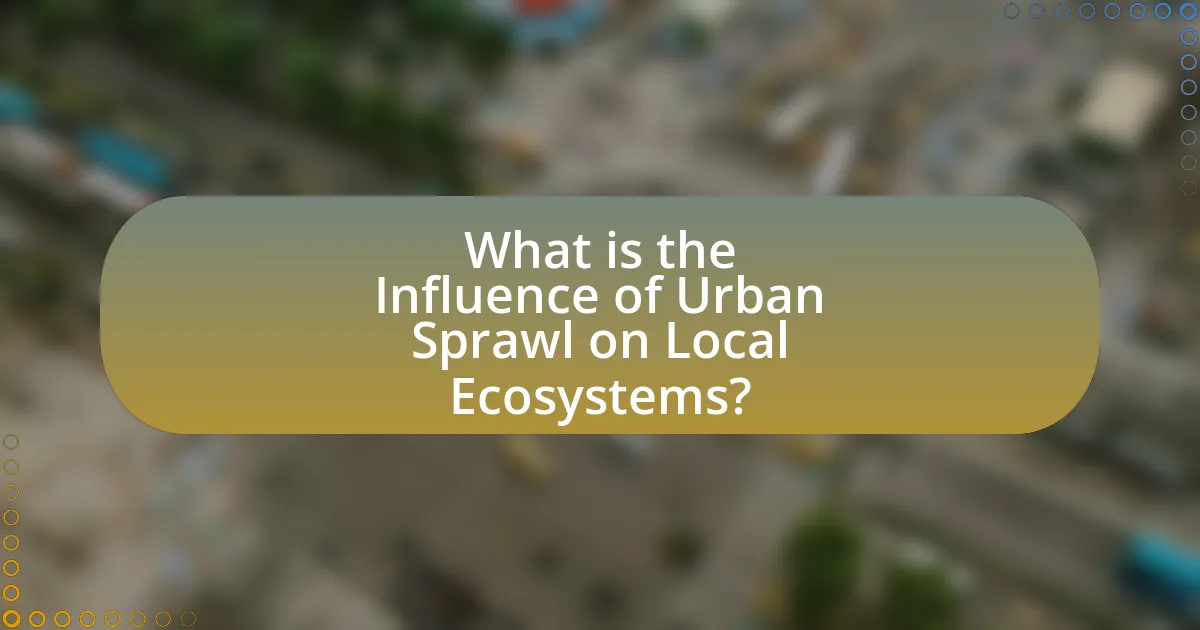
What is the Influence of Urban Sprawl on Local Ecosystems?
Urban sprawl significantly disrupts local ecosystems by fragmenting habitats, increasing pollution, and altering natural water drainage patterns. This expansion of urban areas leads to habitat loss for wildlife, as natural landscapes are converted into residential and commercial developments. Studies indicate that urban sprawl can reduce biodiversity by isolating species populations, making it difficult for them to thrive. Additionally, increased impervious surfaces from roads and buildings contribute to higher runoff and pollution levels in nearby water bodies, negatively impacting aquatic ecosystems. Research published in the journal “Ecological Applications” highlights that urban sprawl is linked to a decline in native species and an increase in invasive species, further stressing local ecosystems.
How does urban sprawl affect biodiversity in local ecosystems?
Urban sprawl negatively impacts biodiversity in local ecosystems by fragmenting habitats and reducing the availability of natural spaces. This fragmentation leads to isolated populations of species, making it difficult for them to find mates, food, and resources necessary for survival. Studies indicate that urban areas often replace diverse ecosystems with monocultures, which diminishes species richness. For example, a study published in the journal “Ecological Applications” found that urbanization can lead to a 50% reduction in native plant species and a corresponding decline in associated wildlife. Additionally, increased pollution and human activity in sprawling areas further threaten the survival of various species, contributing to a decline in overall biodiversity.
What species are most impacted by urban sprawl?
Urban sprawl most significantly impacts species such as amphibians, birds, and mammals. These species are particularly vulnerable due to habitat fragmentation, which disrupts their breeding and foraging grounds. For instance, studies have shown that urban development leads to a decline in amphibian populations by up to 50% in certain areas, as their aquatic habitats are often destroyed or polluted. Additionally, bird species that rely on specific habitats, such as grasslands and forests, face population declines of 30% or more due to habitat loss from urban expansion. Mammals, including deer and foxes, may adapt to urban environments, but their overall populations can suffer due to increased vehicle collisions and reduced access to natural resources.
How does habitat fragmentation occur due to urban sprawl?
Habitat fragmentation occurs due to urban sprawl when expanding urban areas encroach upon natural landscapes, dividing ecosystems into smaller, isolated patches. This process is driven by the development of residential, commercial, and industrial zones, which disrupts the continuity of habitats and creates barriers for wildlife movement. For instance, a study by the U.S. Geological Survey found that urbanization can reduce habitat connectivity by up to 70%, leading to decreased biodiversity and increased vulnerability of species. As urban sprawl continues, the remaining habitat fragments become more susceptible to edge effects, such as increased predation and competition, further exacerbating the decline of local ecosystems.
What are the ecological consequences of urban sprawl?
Urban sprawl leads to significant ecological consequences, including habitat destruction, increased pollution, and loss of biodiversity. As urban areas expand, natural habitats are often cleared for development, resulting in the displacement of wildlife and fragmentation of ecosystems. This habitat loss contributes to a decline in species populations, as many plants and animals struggle to adapt to altered environments. Additionally, urban sprawl increases impervious surfaces, which exacerbates stormwater runoff and water pollution, negatively impacting local waterways and aquatic life. Studies indicate that urban sprawl can reduce biodiversity by up to 30% in affected areas, highlighting the profound impact of urban expansion on local ecosystems.
How does urban sprawl contribute to pollution in local ecosystems?
Urban sprawl contributes to pollution in local ecosystems primarily through increased vehicle emissions, habitat destruction, and runoff from impervious surfaces. As urban areas expand, more land is converted for residential and commercial use, leading to the loss of green spaces that naturally filter pollutants. This expansion results in higher traffic volumes, which significantly elevate air pollution levels; for instance, studies indicate that urban areas can have up to 50% higher levels of nitrogen oxides compared to rural areas. Additionally, the creation of roads and buildings increases impervious surfaces, causing stormwater runoff that carries pollutants like oil, heavy metals, and chemicals into local waterways, further degrading water quality and harming aquatic ecosystems.
What role does urban sprawl play in climate change effects on ecosystems?
Urban sprawl significantly exacerbates climate change effects on ecosystems by increasing greenhouse gas emissions and disrupting natural habitats. The expansion of urban areas leads to higher energy consumption, primarily from transportation and heating, which contributes to elevated carbon dioxide levels. For instance, a study by the U.S. Environmental Protection Agency indicates that urban areas account for approximately 70% of global carbon emissions. Additionally, urban sprawl fragments ecosystems, reducing biodiversity and altering local climate patterns, which can lead to habitat loss and increased vulnerability of species to climate change. This disruption can result in shifts in species distribution and changes in ecosystem services, further intensifying the impacts of climate change on local environments.
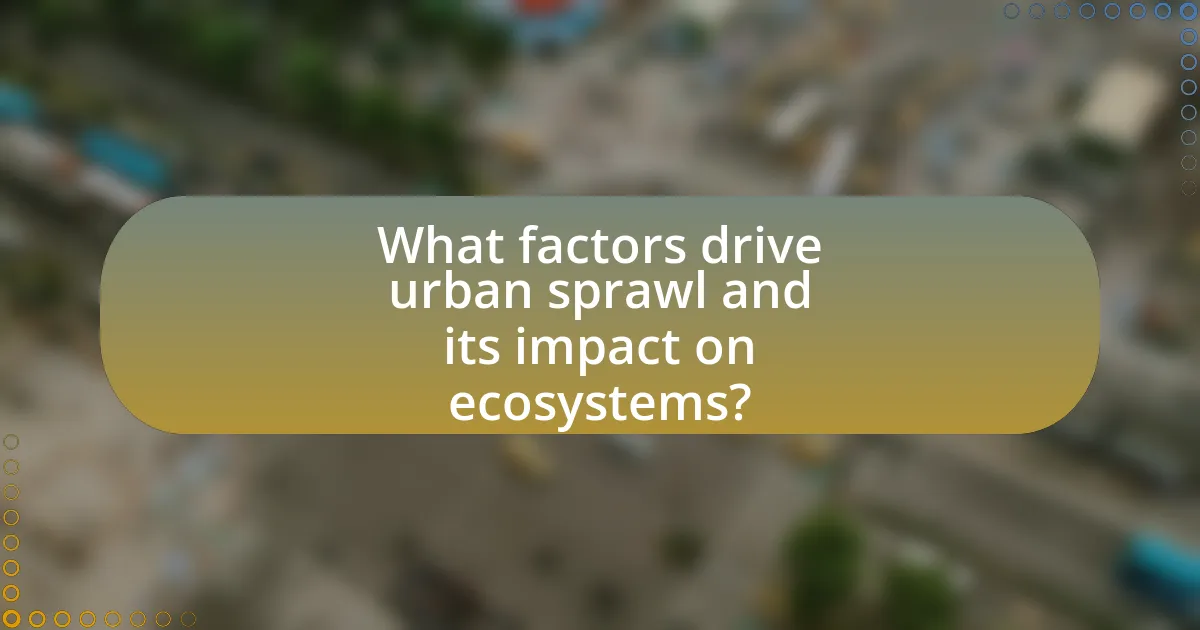
What factors drive urban sprawl and its impact on ecosystems?
Urban sprawl is primarily driven by factors such as population growth, economic development, and transportation infrastructure expansion. Population growth leads to increased housing demand, prompting the expansion of urban areas into surrounding rural land. Economic development encourages businesses to establish in suburban areas, further promoting sprawl. Additionally, the expansion of transportation infrastructure, such as highways, facilitates easier access to previously remote areas, making them attractive for residential and commercial development.
The impact of urban sprawl on ecosystems is significant, resulting in habitat loss, increased pollution, and altered water cycles. Habitat loss occurs as natural landscapes are converted into urban environments, threatening biodiversity. Increased pollution arises from higher vehicle emissions and runoff from impervious surfaces, which can contaminate local waterways. Furthermore, urban sprawl disrupts natural water cycles by increasing impervious surfaces, leading to greater runoff and reduced groundwater recharge. These ecological changes can have long-term consequences for local flora and fauna, as well as for human communities reliant on healthy ecosystems.
How do economic factors influence urban sprawl?
Economic factors significantly influence urban sprawl by driving demand for housing and land in suburban areas. As populations grow and urban centers become congested, individuals and families seek more affordable housing options, often leading to the expansion of urban boundaries into rural areas. For instance, the U.S. Census Bureau reported that between 2000 and 2010, suburban areas experienced a population increase of 12.1%, compared to just 3.1% in urban centers, highlighting the economic push for more space and lower costs. Additionally, the availability of transportation infrastructure, such as highways and public transit, further facilitates this sprawl by making distant areas more accessible, thus increasing their attractiveness for residential development. Economic incentives, such as lower property taxes in suburban regions, also encourage developers to build in these areas, contributing to the overall trend of urban sprawl.
What is the relationship between housing demand and urban sprawl?
Housing demand directly drives urban sprawl, as increased demand for residential properties leads to the expansion of urban areas into surrounding rural or undeveloped land. When populations grow or when individuals seek more affordable housing options, developers respond by constructing new homes on the outskirts of cities, resulting in the spread of urban development. According to the U.S. Environmental Protection Agency, urban sprawl is characterized by low-density development and increased reliance on automobiles, which is often a consequence of housing demand outpacing available urban space. This relationship highlights how rising housing demand can lead to significant changes in land use and environmental impacts, such as habitat loss and increased pollution.
How do transportation developments contribute to urban sprawl?
Transportation developments contribute to urban sprawl by facilitating easier access to previously remote areas, leading to increased residential and commercial expansion. Improved road networks, highways, and public transit systems enable people to live farther from city centers, resulting in the spread of low-density housing and suburban developments. For instance, studies have shown that the construction of new highways often correlates with a rise in population density in surrounding areas, as seen in the United States during the post-World War II era, where highway expansion significantly influenced suburban growth patterns. This pattern of development not only alters land use but also impacts local ecosystems by fragmenting habitats and increasing pollution levels.
What social factors contribute to urban sprawl?
Social factors that contribute to urban sprawl include population growth, socioeconomic status, and lifestyle preferences. Population growth drives demand for housing, leading to the expansion of urban areas into surrounding rural land. Socioeconomic status influences individuals’ ability to purchase homes in suburban areas, often resulting in a preference for larger properties that require more land. Additionally, lifestyle preferences, such as the desire for larger living spaces and access to amenities, encourage families to move away from city centers, further promoting sprawl. According to the U.S. Census Bureau, suburban areas have seen significant population increases, reflecting these social dynamics.
How does population growth affect urban sprawl?
Population growth significantly contributes to urban sprawl by increasing the demand for housing and infrastructure. As more people move into urban areas, cities expand outward to accommodate the rising population, leading to the development of residential, commercial, and industrial zones in previously undeveloped land. According to the U.S. Environmental Protection Agency, urban sprawl has been linked to population increases, with studies showing that metropolitan areas in the United States have expanded by over 50% in land area since 1970, while the population growth has been substantial. This expansion often results in the conversion of natural habitats into urban landscapes, which can disrupt local ecosystems and biodiversity.
What role do zoning laws play in urban sprawl?
Zoning laws significantly influence urban sprawl by regulating land use and development patterns. These laws dictate how land can be utilized, often promoting low-density residential areas that encourage expansion into previously undeveloped regions. For instance, in many U.S. cities, zoning regulations have historically favored single-family homes over multi-family units, leading to increased land consumption and the spread of urban areas into rural landscapes. This pattern of development contributes to habitat loss and fragmentation, impacting local ecosystems by reducing biodiversity and altering natural habitats.
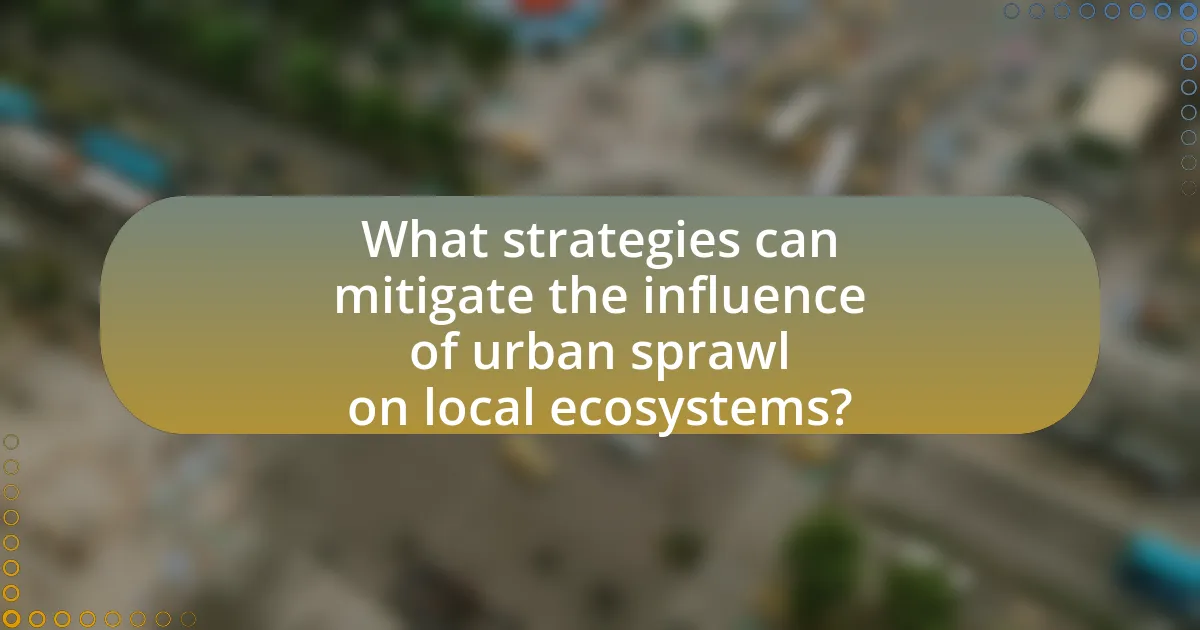
What strategies can mitigate the influence of urban sprawl on local ecosystems?
Implementing smart growth strategies can effectively mitigate the influence of urban sprawl on local ecosystems. Smart growth emphasizes higher-density development, mixed-use zoning, and the preservation of open spaces, which collectively reduce habitat fragmentation and protect biodiversity. For instance, a study by the American Planning Association found that communities adopting smart growth principles experienced a 30% reduction in land consumption compared to traditional development patterns, thereby preserving more natural habitats. Additionally, integrating green infrastructure, such as parks and green roofs, enhances urban biodiversity and improves ecosystem services, as evidenced by research published in the journal “Ecological Applications,” which highlights the positive impacts of urban green spaces on local wildlife populations.
How can urban planning reduce the negative impacts of urban sprawl?
Urban planning can reduce the negative impacts of urban sprawl by promoting higher-density development, mixed-use zoning, and efficient public transportation systems. Higher-density development minimizes land consumption and preserves green spaces, which are crucial for local ecosystems. Mixed-use zoning encourages the integration of residential, commercial, and recreational spaces, reducing the need for long commutes and thereby lowering vehicle emissions. Efficient public transportation systems further decrease reliance on cars, leading to reduced traffic congestion and pollution. Studies have shown that cities with well-planned urban layouts experience less habitat fragmentation and better air quality, demonstrating the effectiveness of strategic urban planning in mitigating the adverse effects of urban sprawl on local ecosystems.
What are the benefits of green spaces in urban areas?
Green spaces in urban areas provide numerous benefits, including improved air quality, enhanced mental health, and increased biodiversity. These areas act as natural air filters, absorbing pollutants and producing oxygen, which contributes to healthier urban environments. Studies have shown that access to green spaces reduces stress and anxiety, promoting mental well-being among city dwellers. Furthermore, green spaces support various species, fostering biodiversity that is crucial for ecosystem stability. For instance, a study published in the journal “Landscape and Urban Planning” found that urban parks can significantly increase local species richness, demonstrating their role in maintaining ecological balance.
How can sustainable development practices help local ecosystems?
Sustainable development practices can significantly enhance local ecosystems by promoting biodiversity and reducing environmental degradation. These practices, such as implementing green infrastructure, conserving natural habitats, and utilizing sustainable land-use planning, help maintain ecological balance. For instance, a study by the United Nations Environment Programme highlights that urban areas adopting green roofs and permeable surfaces can reduce stormwater runoff by up to 65%, thereby protecting aquatic ecosystems from pollution. Additionally, sustainable agriculture techniques, like crop rotation and organic farming, can improve soil health and increase habitat diversity, which supports various species. Overall, integrating sustainable development into urban planning directly benefits local ecosystems by fostering resilience and sustainability.
What community actions can support ecosystem health in urban areas?
Community actions that can support ecosystem health in urban areas include creating green spaces, implementing urban gardening initiatives, and promoting biodiversity through native plant landscaping. Green spaces, such as parks and community gardens, enhance air quality, reduce urban heat, and provide habitats for wildlife. Urban gardening initiatives encourage local food production, which can reduce carbon footprints associated with food transportation. Additionally, landscaping with native plants supports local ecosystems by providing food and shelter for native species, which is crucial for maintaining biodiversity. Studies show that urban green spaces can improve mental health and community cohesion, further reinforcing their importance in urban planning.
How can local initiatives promote biodiversity conservation?
Local initiatives can promote biodiversity conservation by implementing community-driven projects that restore habitats and protect native species. For example, urban community gardens enhance green spaces, which support pollinators and other wildlife, thereby increasing local biodiversity. Research indicates that urban green spaces can improve species richness by providing essential resources and habitats for various organisms. Additionally, local initiatives often involve educational programs that raise awareness about the importance of biodiversity, leading to increased community engagement and stewardship. This collective action can result in more effective conservation efforts, as seen in programs like the National Wildlife Federation’s Community Wildlife Habitat program, which has successfully transformed urban areas into wildlife-friendly spaces.
What role do community gardens play in enhancing local ecosystems?
Community gardens play a crucial role in enhancing local ecosystems by promoting biodiversity and improving soil health. These gardens provide habitats for various species, including pollinators like bees and butterflies, which are essential for plant reproduction. Research indicates that urban areas with community gardens have higher species richness compared to those without, as these gardens serve as green corridors that connect fragmented habitats. Additionally, community gardens contribute to soil improvement through organic practices, which enhance nutrient cycling and reduce erosion. Studies have shown that urban gardening can increase soil organic matter by up to 30%, thereby fostering healthier ecosystems.
What best practices can individuals adopt to minimize urban sprawl effects?
Individuals can minimize urban sprawl effects by adopting practices such as supporting local businesses, utilizing public transportation, and advocating for sustainable land-use policies. Supporting local businesses reduces the need for extensive commuting, which in turn decreases traffic congestion and pollution associated with urban sprawl. Utilizing public transportation can significantly lower individual carbon footprints, as studies show that public transit produces 45% less carbon dioxide per mile than private vehicles. Advocating for sustainable land-use policies encourages the development of compact, mixed-use neighborhoods that preserve green spaces and reduce the spread of urban areas into rural lands. These practices collectively contribute to more sustainable urban environments and help protect local ecosystems from the adverse effects of sprawl.
